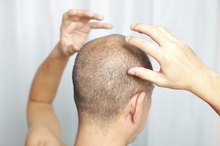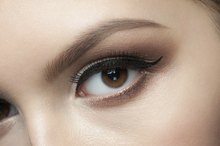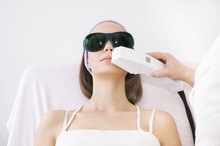Dihydrotestosterone, or DHT, is a natural metabolite of the male sex hormone testosterone. DHT occurs naturally in both men and women, since both genders have testosterone, although in sharply varying amounts. DHT plays a significant role in androgenetic alopecia, a common cause of hair loss, according to hair and scalp specialist David H. Kingsley, Ph.D 1. If you’re waging a battle against hair loss, you might be surprised to learn that caffeine can help counteract the effects of DHT.
Functions of DHT
Like its chemical precursor testosterone, DHT is an androgen, a hormone that stimulates the development of male characteristics, according to the Society for Endocrinology. The prostate and testes in men and the ovaries in women, as well as other body systems in both genders, convert roughly 10 percent of each day’s testosterone production into DHT. The production of DHT in males ramps up before puberty and is believed responsible for the development of male genitalia and the growth of body and pubic hair. Although less is known about the role of DHT in women, it appears linked to the growth of body and pubic hair as well and may help to determine the onset of puberty.
- Like its chemical precursor testosterone, DHT is an androgen, a hormone that stimulates the development of male characteristics, according to the Society for Endocrinology.
- The production of DHT in males ramps up before puberty and is believed responsible for the development of male genitalia and the growth of body and pubic hair.
Androgenetic Alopecia
How to Stop Hair From Growing on the Belly if You've Shaved It
Learn More
Androgenetic alopecia, sometimes called male pattern baldness, can cause hair loss in both males and females. In this form of hair loss, the hairline gradually recedes, creating an “M” shape, according to PubMed Health, a service of the U.S. National Library of Medicine. Although there is a genetic predisposition for this form of hair loss, male sex hormones -- most notably DHT -- also play a significant role.
While hair follicles on the front and crown of the head have receptors for DHT, the hair follicles on the sides and back of the head do not, according to D.J. Verret, M.D., author of “Patient Guide to Hair Loss & Hair Restoration.” This accounts for the common patterns of hair loss, which tend to start with a receding hairline at the front and a noticeable thinning of the hair on the crown of the head 3.
- Androgenetic alopecia, sometimes called male pattern baldness, can cause hair loss in both males and females.
- While hair follicles on the front and crown of the head have receptors for DHT, the hair follicles on the sides and back of the head do not, according to D.J.
- Verret, M.D., author of “Patient Guide to Hair Loss & Hair Restoration.”
Role of DHT in Hair Loss
Over time, DHT tends to shorten the growing phase of your hair’s cycle, which allows the cycle’s resting phase to grow longer, according to David H. Kingsley, Ph.D., author of “The Hair-Loss Cure.” The hormone also gradually reduces the size of the affected follicles, which causes those hairs to become shorter and much finer in texture 1.cause:
- Over time
- DHT tends to shorten the growing phase of your hair’s cycle
- which allows the cycle’s resting phase to grow longer
- according to David H
Kingsley
Ph.D.
author of “The Hair-Loss Cure.” The hormone also gradually reduces the size of the affected follicles
which causes those hairs to become shorter
much finer in texture 1. As this process continues and accelerates, so does your loss of hair.
How Caffeine Helps
Widow's Peak and Hair Loss
Learn More
A team of German researchers found that caffeine blocks the damaging effects of DHT on hair follicles and stimulates the growth of new hair. Researchers published their findings in the January 2007 issue of the “International Journal of Dermatology.” Researchers based their findings on an in vitro study of caffeine’s effect on hair follicle proliferation. However, drinking more coffee, tea and cola is probably not going to do much to save your hair, according to a Mail Online article by Pat Hagan. The author points that you'll need topical applications of a caffeine-rich lotion or cream to block the damaging effects of DHT and stimulate hair growth.
- A team of German researchers found that caffeine blocks the damaging effects of DHT on hair follicles and stimulates the growth of new hair.
- The author points that you'll need topical applications of a caffeine-rich lotion or cream to block the damaging effects of DHT and stimulate hair growth.
Related Articles
References
- The Hair-Loss Cure; David H. Kingsley
- Society for Endocrinology: You and Your Hormones: Dihydrotestosterone
- Patient’s Guide to Hair Loss & Hair Restoration; D.J. Verret
- MailOnline: Coffee Could Hold the Cure for Baldness
- Phillips TG, Slomiany WP, Allison R. Hair Loss: Common Causes and Treatment. Am Fam Physician. 2017;96(6):371-378.
- Watras MM, Patel JP, Arya R. Traditional anticoagulants and hair loss: a role for direct oral anticoagulants? A review of the literature. Drugs Real World Outcomes. 2016;3(1):1-6. doi:10.1007/s40801-015-0056-z
- Urysiak-czubatka I, Kmieć ML, Broniarczyk-dyła G. Assessment of the usefulness of dihydrotestosterone in the diagnostics of patients with androgenetic alopecia. Postepy Dermatol Alergol. 2014;31(4):207-15. doi:10.5114/pdia.2014.40925
- Vincent M, Yogiraj K. A descriptive study of alopecia patterns and their relation to thyroid dysfunction. Int J Trichology. 2013;5(1):57-60. doi:10.4103/0974-7753.114701
- Peters EMJ, Müller Y, Snaga W, et al. Hair and stress: A pilot study of hair and cytokine balance alteration in healthy young women under major exam stress. PLoS ONE. 2017;12(4):e0175904. doi:10.1371/journal.pone.0175904
- Pratt CH, King LE, Messenger AG, Christiano AM, Sundberg JP. Alopecia areata. Nat Rev Dis Primers. 2017;3:17011. doi:10.1038/nrdp.2017.11
- American Academy of Dermatology. Alopecia Areata: Overview.
Writer Bio
Don Amerman has spent his entire professional career in the editorial field. For many years he was an editor and writer for The Journal of Commerce. Since 1996 he has been freelancing full-time, writing for a large number of print and online publishers including Gale Group, Charles Scribner’s Sons, Greenwood Publishing, Rock Hill Works and others.









